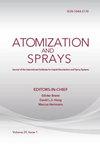Application of an Optimized Mechanism of Primary Reference Fuel to Single Hole Sprays
IF 0.9
4区 工程技术
Q4 ENGINEERING, CHEMICAL
引用次数: 0
Abstract
The present work focuses on the derivation and evaluation of a chemical kinetic mechanism of Primary Reference Fuel (PRF, binary blends of n-heptane and isooctane) with a homogeneous reactors approach starting from a detailed one. Results show that the optimized mechanism can replicate the results of the detailed one with high accuracy. The mechanism is integrated into a Computational Fluid Dynamics workflow combining a Reynolds-Averaged Navier–Stokes approach, a diffuse-interface spray and an unsteady flamelet progress variable combustion models. The workflow is validated against spray combustion measurements following the standards of the Engine Combustion Network (ECN). Test cases sweep binary blends of PRF fuels from pure n-heptane to pure iso-octane using an ECN Spray A nozzle. The model can provide accurate predictions of typical reacting spray metrics such as ignition delay and lift-off length, which have been evaluated following a reconstruction of the experimental methods of schlieren and OH* chemiluminescence. Different definitions of the previous combustion metrics have been compared. The model captures the decreasing reactivity with increasing iso-octane fraction, which results in flame stabilizing at much leaner conditions. However, deficiencies are observed for low reactivity cases, either with high PRF or low temperature cases.在单孔喷射中应用初级参考燃料的优化机制
本研究的重点是在详细机制的基础上,采用均相反应器方法推导和评估初级参考燃料(PRF,正庚烷和异辛烷的二元混合物)的化学动力学机制。结果表明,优化后的机理可以高精度地复制详细机理的结果。该机制被集成到计算流体动力学工作流程中,该流程结合了雷诺平均纳维-斯托克斯方法、扩散界面喷雾和非稳态火焰小进变量燃烧模型。按照发动机燃烧网络(ECN)的标准,根据喷雾燃烧测量结果对工作流程进行了验证。测试案例使用 ECN 喷雾 A 喷嘴对从纯正庚烷到纯异辛烷的 PRF 燃料二元混合物进行了扫描。该模型可以准确预测典型的反应喷雾指标,如点火延迟和升空长度,这些指标是通过重构裂片和 OH* 化学发光实验方法进行评估的。对之前燃烧指标的不同定义进行了比较。该模型捕捉到了反应性随异辛烷组分增加而降低的现象,这导致火焰在更稀的条件下趋于稳定。然而,在低反应性情况下,无论是高 PRF 还是低温情况下,都会出现缺陷。
本文章由计算机程序翻译,如有差异,请以英文原文为准。
求助全文
约1分钟内获得全文
求助全文
来源期刊

Atomization and Sprays
工程技术-材料科学:综合
CiteScore
2.10
自引率
16.70%
发文量
54
审稿时长
1.7 months
期刊介绍:
The application and utilization of sprays is not new, and in modern society, it is extensive enough that almost every industry and household uses some form of sprays. What is new is an increasing scientific interest in atomization - the need to understand the physical structure of liquids under conditions of higher shear rates and interaction with gaseous flow. This need is being met with the publication of Atomization and Sprays, an authoritative, international journal presenting high quality research, applications, and review papers.
 求助内容:
求助内容: 应助结果提醒方式:
应助结果提醒方式:


